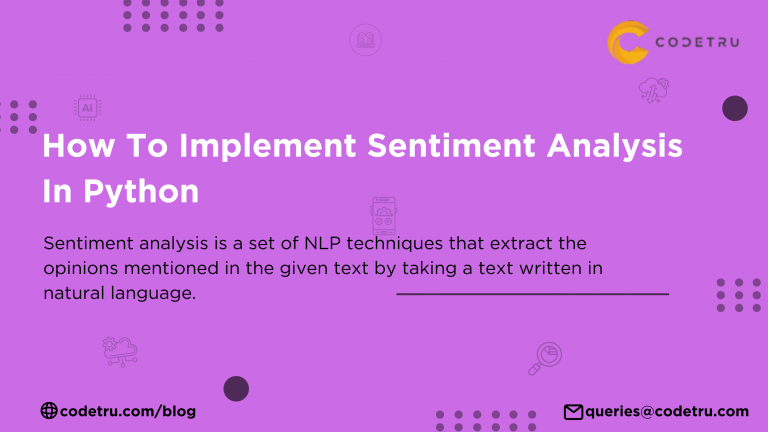Sentiment Analysis
The Challenge
Sentiment analysis is the process of analyzing a text to identify subjective opinions and classify them as positive, negative, or neutral.
To understand it in detail, let’s consider an example where you receive a lot of text in the form of online product reviews, NPS responses, or conversations on Twitter. All of these texts are crucial for your business and brand reputation, as they provide valuable data. Knowing the overall sentiment expressed by customers in each piece of text can be insightful. While analyzing a small content piece is manageable, handling a large volume of data can take hours or even days if done manually.
Sentiment Analysis: Understanding Its Definition and Purpose
Sentiment analysis is a set of Natural Language Processing (NLP) techniques that extract the opinions mentioned in the given text by taking a text written in natural language. This might be in the form of academic circles or a document.
The objective of Sentiment Analysis may be understood as a process to take a text and produce a label (or labels) that describes briefly the sentiment of that text, e.g. positive, neutral, and negative. Let’s say for instance we are looking at hotel reviews and the sentence ‘The support from the hotel staff was of first class” would be labeled as Positive and the sentence ‘The shared bathroom provided was not comfortable and disgusting’ to be labeled as Negative.
If you are asking a machine to do this for you then it is not an easy task. The skills required for this would be knowledge of different fields such as Statistics, Computer Science, and Linguistics.
Importance of Sentiment Analysis
Sentiment Analysis in a nutshell a boon to businesses as it helps them with easy and quick processing and extraction of actionable insights from large text volumes without reading it. To be precise, this technique is useful in understanding the user behavior about something measurable. This can help businesses understand customer behavior on social media platforms, product reviews, or NPS comments. Sentiment Analysis is a method to enhance an organization’s understanding of customer opinions and actions.
Sentiment Analysis is an automated process that allows you to perform analysis of texts in real-time and always against the same set of criteria. You aren’t dealing with several people with different biases at work, but rather with a single unified system that has a consistent output.
How to Do Sentiment Analysis in Python?
This can begin from scratch by introducing your application or using any of the well-recognized open-source libraries available such as Scikit-learn.
This looks easy however might be a tedious task to implement. Machine Learning is not easy and it takes efforts of resources to build and a bunch of expert data scientists. Then there would be a need for the collection of data chunks of the utmost quality which will be used to train the models, source some hardware (including GPUs) for running the software on, and test it continuously to get a solution that works.. Then, when it’s built and is working more resources are required to integrate the new module into your existing solution, to maintain it, and to keep it updated.
Step-by-Step Guide: Implementing Sentiment Analysis in Python
To implement sentiment analysis in Python, follow this detailed step-by-step guide using popular libraries such as Scikit-learn, NLTK, and TextBlob. This approach will help you effectively analyze and classify text data.
1. Setup Your Environment
First, ensure you have Python installed, and then install the necessary libraries. You can use pip to install them.
pip install scikit-learn nltk textblob2. Import Required Libraries
Start by importing the libraries you’ll use for sentiment analysis:
import nltk
from nltk.corpus import stopwords
from nltk.tokenize import word_tokenize
from textblob import TextBlob
from sklearn.feature_extraction.text import CountVectorizer
from sklearn.model_selection import train_test_split
from sklearn.naive_bayes import MultinomialNB
from sklearn import metrics3. Download NLTK Data
Download necessary NLTK data for tokenization and stop words:
nltk.download('punkt')
nltk.download('stopwords')4. Prepare Your Data
Load and preprocess your dataset. For this example, we assume you have a dataset with text and sentiment labels:
import pandas as pd
# Load dataset
data = pd.read_csv('sentiment_data.csv')
# Preprocess text
def preprocess_text(text):
tokens = word_tokenize(text.lower())
tokens = [word for word in tokens if word.isalpha()]
tokens = [word for word in tokens if word not in stopwords.words('english')]
return ' '.join(tokens)
data['processed_text'] = data['text'].apply(preprocess_text)5. Feature Extraction
Convert text data into numerical features using CountVectorizer:
vectorizer = CountVectorizer()
X = vectorizer.fit_transform(data['processed_text'])
y = data['sentiment']6. Split Data
Split the dataset into training and testing sets:
X_train, X_test, y_train, y_test = train_test_split(X, y, test_size=0.2, random_state=42)7. Train a Model
Train a sentiment analysis model using the Naive Bayes classifier:
model = MultinomialNB()
model.fit(X_train, y_train)8. Evaluate the Model
Evaluate the model’s performance on the test set:
y_pred = model.predict(X_test)
print("Accuracy:", metrics.accuracy_score(y_test, y_pred))
print("Confusion Matrix:\n", metrics.confusion_matrix(y_test, y_pred))
print("Classification Report:\n", metrics.classification_report(y_test, y_pred))9. Use TextBlob for Sentiment Analysis
For a quick sentiment analysis, you can use TextBlob:
def analyze_sentiment(text):
blob = TextBlob(text)
return blob.sentiment.polarity
sample_text = "I love the new design of the product!"
print("Sentiment Score:", analyze_sentiment(sample_text))10. Fine-Tuning and Customization
You can further refine your model by experimenting with different algorithms, feature extraction methods, and tuning hyperparameters based on your specific use case and data.
By following these steps, you can effectively implement sentiment analysis in Python, gaining valuable insights from text data to enhance your business or research objectives.
Creating Your Sentiment Analysis Model
The important thing to remember in Machine Learning is that a model will perform well on texts that are similar to the texts that are used to train it.
In case the texts differ in this model then it will not be compliant and effective that means If you have trained your sentiment analysis model using survey responses then it will work If the texts differ then this model will not be effective, meaning if you have trained your sentiment analysis model by using survey responses then it will work perfectly for any or all new survey responses. However, it will not give a good response to other variations such as tweets.
Generic sentiment analysis models are pretty good for many use cases and getting started right away, but sometimes it’s not enough — you need a custom model trained with your data. We put a lot of love into creating our models, and they were trained with a lot of data, but their performance can be improved upon for smaller and more specific problems.
Another reason why you might want to train your custom model is the labeling criteria. Consistency is considered as one of the main requisites of automatic classification but if the original criteria used for labeling is not useful for your case, then the model will not work for you. In other words, what is negative for one organization may be a positive one for you.
Data for Training the Model
There is a saying that goes, garbage in is the garbage out holds for the training data of machine learning. Without quality data, the model is never considered a good one. For this example, you can use this dataset, composed of texts from hotel reviews. The dataset is a CSV file with two columns: Text and Sentiment, which can be one for negative or positive.
Not all the texts of the dataset are tagged. API will train a model with the tagged texts, and then you can keep improving the model by tagging more texts yourself using our UI.
Training the Sentiment Analysis Model
Training a sentiment analysis model is straightforward and efficient. Here’s a step-by-step overview of how to create and train your custom model:
1. Prepare Your Data
- Start by gathering and preparing your dataset. This data could be from various sources such as customer reviews, social media posts, or survey responses.
- Ensure your dataset is clean and well-organized, with texts labeled according to sentiment (e.g., positive, negative, neutral).
2. Upload Your Data
- Use a user-friendly interface or API to upload your data. Most sentiment analysis platforms provide tools for easy data upload.
- If your dataset needs tagging or labeling, do so as part of the upload process. Accurate labels are crucial for training a reliable model.
3. Configure the Training
- Once your data is uploaded, you may need to configure certain parameters, although many platforms handle this automatically.
- The system will choose the best parameters and algorithms based on your data to optimize the training process.
4. Model Training
- The training process involves the model learning from the data you’ve provided. The platform uses advanced machine learning algorithms to identify patterns and relationships in the text data.
- This step is typically automated, allowing the model to fine-tune itself based on the provided data.
5. Evaluate and Refine
- After training, evaluate the model’s performance using a validation dataset to ensure it meets your accuracy and reliability standards.
- If needed, you can refine the model by adjusting parameters or adding more data to improve its accuracy.
6. Integration
- Once your model is trained and validated, integrate it into your existing systems or applications.
- This integration allows you to analyze new text data in real time and gain actionable insights.
7. Continuous Improvement
- Monitor the model’s performance regularly and update it with new data to maintain its accuracy and relevance.
- Continuously refining the model ensures it adapts to changing trends and maintains high performance.
FAQs on Implementing Sentiment Analysis in Python
1. What is sentiment analysis in Python?
Sentiment analysis in Python is a technique that uses natural language processing (NLP) techniques to analyze and categorize data into sentiments such as positive, negative, or neutral Python uses libraries such as Scikit-learn, NLTK, and TextBlob to facilitate sensitivity analysis.
2. Why is sentiment analysis important for businesses?
Sentiment analytics is important for businesses because it helps them to rapidly process large amounts of data such as customer reviews, social media posts, survey responses, etc. By extracting actionable insights from this data through, businesses can understand customer perspectives, improve products, and increase customers by leaps and bounds.
3. How can I perform sentiment analysis using Python?
You can use libraries such as NLTK, TextBlob, or Scikit-learn to perform sentiment analysis in Python. These libraries provide pre-built functions and examples for analyzing textual data. You can also train custom models using machine-learning techniques for specific requirements.
4. What datasets are useful for training sentiment analysis models?
High-quality data sets are needed to train effective sensitivity analysis models. Publicly available datasets such as the IMDB movie review dataset, Amazon product reviews, and the Twitter sentiment analysis dataset are often used. You can also create custom datasets specific to your domain for better accuracy.
5. What are the challenges in implementing sentiment analysis?
Challenges in implementing sentiment analysis include handling sarcasm, context, and varying expressions of sentiment. In addition, it is important to ensure the quality and relevance of the training data, maintain the computational resources required for model training, and continuously update the model to new data are significant hurdles.







